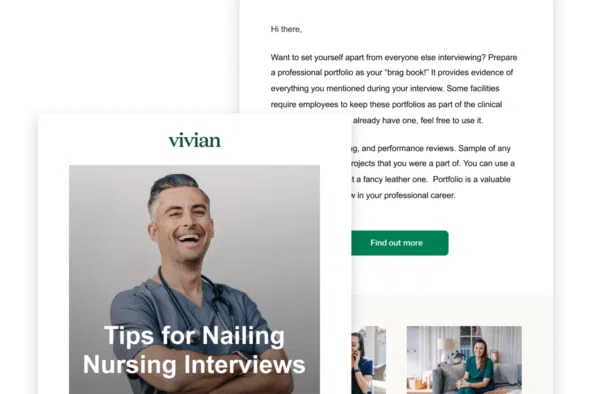Fewer people are enrolling in RN-to-BSN programs. Here’s what that means for the future of nursing.
Stressful working conditions and workforce shortages during the COVID-19 pandemic contributed to burnout among nurses, so much so that about 100,000 registered nurses left the industry, according to the National Council of State Boards of Nursing. While COVID isn’t straining the U.S. healthcare system as much as at the start of the pandemic, staffing issues and the demanding work environment persist.
By 2027, about 1 in 5 nurses are expected to leave the industry, and there may not be enough nurses in the next generation to fill the gap. The 2022-23 school year marked the fourth year in a row that enrollment in RN-to-BSN programs declined, falling to below 100,000 students nationwide.
Vivian Health examined data from the American Association of Colleges of Nursing and other sources to see what’s behind the decline in students enrolling in nursing schools.
Reasons for Nursing Student Decline
Employers are looking to fill vacant roles with more highly educated nurses, according to the AACN. Over 70% prefer Bachelor of Science in Nursing (BSN) program graduates versus RNs with just an associate degree, saying that a higher degree provides the necessary education and experience for the evolving industry.
Around the country, however, 2022-23 enrollments in RN-to-BSN programs have fallen compared to the prior school year, down nearly 21% in the North Atlantic region, 18% in the South, about 18% in the West and 13% in the Midwest.
During this time, declines have also spanned all racial demographics. American Indian/Alaskan Natives have experienced the greatest decline, with enrollments down around 20% between 2022 and 2023. While Black students showed the smallest decline of 12%, the dip in enrollment is still significant.
Enrollment declines in RN-to-BSN programs, however, aren’t due to a lack of interest. More than 66,000 qualified applications from qualified prospective BSN students were rejected. And while the competition can be fierce in some areas of the country—in California, nearly 75% of qualified applicants weren’t accepted for the 2021-22 school year—staffing shortages have also plagued nursing education.
Just under 8% of full-time faculty positions are open nationwide, with 2,000 teachers needed to fill those slots. Shortages also extend to part-time teachers, clinical placements and preceptors to supervise clinical rotations.
Budget cuts at schools are also responsible for lower enrollment, as schools have fewer resources for students and aren’t able to offer faculty pay that’s competitive with clinical practice.

Nursing School Enrollment Drops to Decade-Low
Rather than face a yearslong waitlist, many students turn to private universities for nursing degrees. In many cases, this means six-figure tuition costs but higher median salaries. According to the Bureau of Labor Statistics, the median wage for registered nurses in 2022 was $81,220, compared to about $74,464 for all workers with bachelor’s degrees. Nonetheless, enrollment has still declined by 16% for private universities, compared to 15% for public universities.
Related: Healthcare Education Loan Forgiveness: A State-by-State Guide
Many public schools are looking for creative ways to boost enrollment through partnerships with community colleges and expanding the number of program start dates in a year.
The nearly 25% decline at religious private schools aligns with an overall enrollment decline at some of these schools due to lower membership in the Catholic church and some Protestant denominations.

Photo Credit: Canva
Governments Ramping Nursing Student Recruitment Efforts
More government investment on a state and federal level may continue to stem the tide. In 2023, Maryland granted $5.8 million in funds to nine schools in the state to address nursing student and faculty shortages.
The federal government is also trying to alleviate the pressures higher education institutions are facing through legislation. In 2022, the Department of Health and Human Services allocated $13 million to support faculty, preceptor and registered nurse training programs.
Congress also introduced legislation in 2023 to create a grant program that assists college faculty recruitment and retention efforts. Although that bill is still in committee, it shows the awareness and desire to support efforts to promote more nursing student enrollment.
Looking for your next nursing role? Browse Vivian’s jobs marketplace and take your career to the next level today.
Story editing by Shanna Kelly. Copy editing by Tim Bruns. Data work by Elena Cox.
Feature Image Credit: Canva










I’d like to read an article addressing the issue of RN shortages and facilities not allowing associate degree nurses to practice because they are unable to get a BSN.